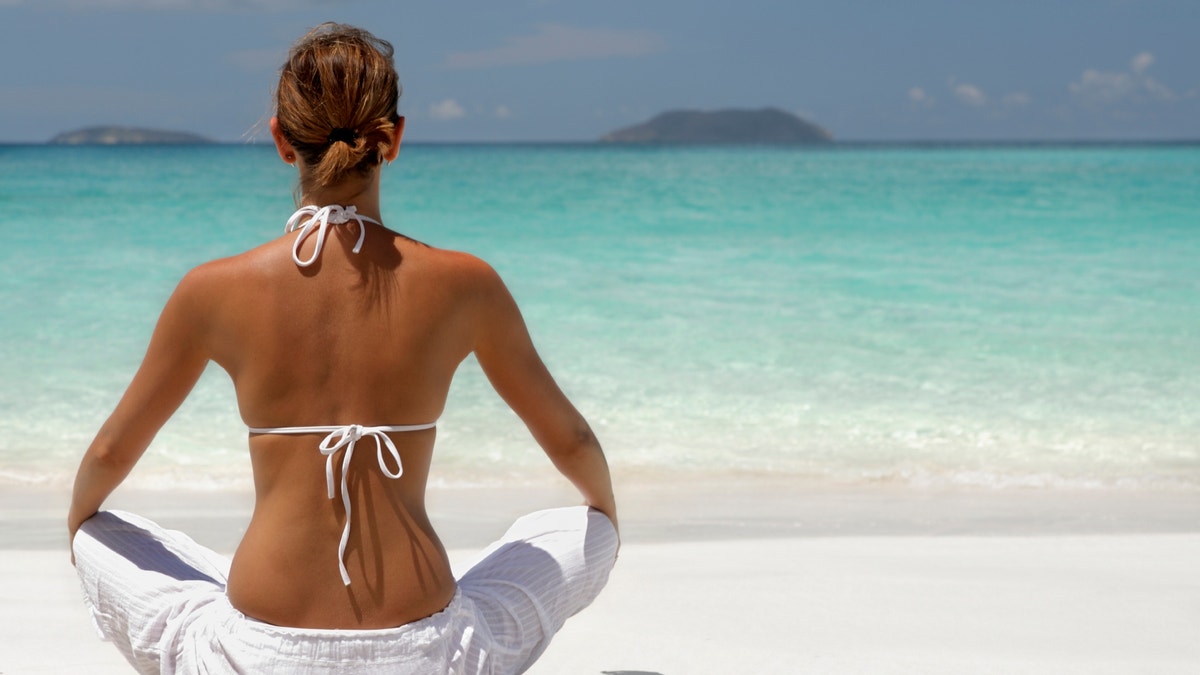
woman meditating on tropical beach in the caribbean
Iyengar, Vinyasa, Kundalini...huh? Find the yoga class or style that fits you best
Ashtanga
What it is: Ashtanga is one of the more physically challenging forms of yoga. Classes go through a sequence of as few as 25 poses (also called asanas) that include back bends, inversions (think headstands and handstands), balances, and twists.
Degree of difficulty: Expect an invigorating work-out. This style of yoga builds strength, stamina, and flexibility. Even beginner classes can be challenging.
Who it’s best for: Athletic types who want a high-energy workout, as well as those who appreciate predictability and order.
Keep in mind: Most classes follow the same prescribed order of poses, so you can expect an the same experience, whether you’re in a studio in Peoria or Portland. A boon if you like to take a yoga class when you’re on the road, but a bore if you thrive on variety.
_______________________________________________
More From Real Simple:
Ideal Walking Workout
Fun Hula-Hoop Exercise Routine
Tighten Your Glutes in 15 Minutes
_______________________________________________
Bikram (a.k.a. Hot Yoga)
What it is: Bikram started becoming popular in America in the late 1970s. Classes are held in a room heated to about 105 degrees, which helps loosen muscles and joints. The 26-pose series is designed to stretch and strengthen your muscles, ligaments, and tendons.
Degree of difficulty: Classes are demanding, since you cycle through the 26-pose series twice. The biggest challenge, however, may be coping with the intense heat. Some say it’s like exercising in a sauna.
Who it’s best for: Devoted yogis who are looking for a new challenge or people who are very fit and want a hard and limbering workout. Before taking a Bikram class, check with your doctor if you are pregnant or have high blood pressure.
Keep in mind: Be prepared to sweat―a lot. Bring an oversize bottle of water to class, and don’t forget a towel. After class, continue to drink water or have a fruit shake or a sports drink to help replenish electrolytes.
Hatha
What it is: This is an umbrella term for all the poses involved in yoga, but in the United States, Hatha is associated with a slower-paced class that includes simple breathing and meditation exercises.
Degree of difficulty: Hatha classes are typically mellow, with an emphasis on balancing strength and flexibility. That said, if your studio or gym rates its class levels from 1 to 3, expect the third level to be fast paced and therefore more strenuous.
Who it’s best for: Those who are new to yoga or people who want a relaxing, meditative experience.
Keep in mind: This is a good place to learn basic asanas, relaxation techniques, and the ways to move from pose to pose. But if the pace of a Hatha class puts you to sleep, don’t give up. Move on to Vinyasa, which is more athletic and rigorous.
Iyengar
What it is: This style is known as the yoga of alignment, since the emphasis is on sustaining precise poses. Students use props, such as straps, blankets, wooden blocks, and chairs, to help them attain the ideal positions.
Degree of difficulty: Classes are intense but not as grueling as, say, Ashtanga. You hold the poses for 30 seconds to two minutes (much longer than in many other yoga classes). You’ll strengthen and stretch your muscles, but you probably won’t be huffing and puffing.
Who it’s best for: People who would rather focus on the subtleties of alignment than a revved-up heart rate.
Keep in mind: Iyengar teachers go through an intense, multiyear training program (compared with as little as a few months for many other styles). The experience of the teachers might be why this is one of the most popular forms of yoga in America.
Kundalini
What it is: Prepare to chant. A typical class starts with a series of breathing exercises and chants, then segues into practicing poses. The classes are designed to release a form of energy (called Kundalini) that is believed by practitioners to be stored at the base of the spine.
Degree of difficulty: Kundalini is less athletic than some of the other styles, but that doesn’t mean it’s easy. The poses are performed in tandem with specific breathing patterns, which can be tricky to master
Who it’s best for: Those who are up for both a mental and physical workout. You’ll focus almost as much on your thoughts and energy as you will on the poses.
Keep in mind: Kundalini is one of the more spiritual and enigmatic forms of yoga. Practitioners believe that by releasing Kundalini energy, you will awaken intuition and gain mental clarity over time.
Vinyasa (a.k.a. Flow Yoga)
What it is: Vinyasa uses breathing as an integral part of movement and is close to Ashtanga in style. But whereas Ashtanga follows a set sequence, here the instructor selects the poses and pace.
Degree of difficulty: The difficulty depends on the sequences chosen by the teacher. You’ll be “flowing” (moving) from one pose to the next with only short breaks. As with Hatha, many classes are rated from 1 to 3.
Who it’s best for: Those who like the moves of Ashtanga but not the repetition of following a set sequence. Vinyasa can easily be adapted to any fitness level.
Keep in mind: Vinyasa classes may feel more westernized than Kundalini or Iyengar. Some teachers play pop music and use the colloquial names for asanas, like Mountain pose or Chair pose, rather than the Sanskrit ones (Tadasana and Utkatasana, respectively).
